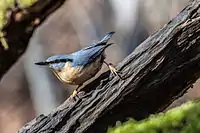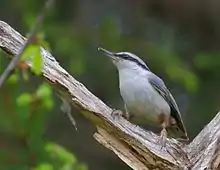

The Eurasian nuthatch (Sitta europaea) is a small passerine bird found throughout temperate Asia and in Europe. There are more than 20 subspecies, but the precise number depends on how small differences between populations are evaluated. This article follows the 2013 Handbook of the Birds of the World Alive treatment, which has more recognised forms than the 1996 Tits, Nuthatches and Treecreepers. Given the similarities between geographical forms of the Eurasian nuthatch, subspecies boundaries are somewhat fluid, although fewer than half as many are recognised now as in 1967.[1]
The Eurasian nuthatch taxa can be divided into three main groups; the S. e. caesia group of Europe, North Africa and the Middle East, the S. e. europaea group of Scandinavia, Russia, Japan and northern China and the S. e. sinensis group of southern and eastern China and Taiwan. These may have been geographically isolated from each other until relatively recently. Birds of intermediate appearance occur where the group ranges overlap. The descriptions below are of the male. The female is usually slightly duller with a brown tint to the eyestripe and paler underparts, although the sexes are very similar in the S. e. sinensis group.[2][3]
S. e. caesia group
The S. e. caesia group is found in much of Europe, as well as North Africa and the Middle East. Members of the subspecies group have buff breast and a white throat.
| Subspecies | Authority | Range | Description |
|---|---|---|---|
| S. e. caesia | Wolf, 1810[4] | Much of western Europe south to northern Spain, the Alps, Greece and western Turkey, north to Denmark, and east to the western regions of Poland, Romania and Bulgaria. | Upperparts blue grey, black eye-stripe, white throat. Rest of underparts orange-buff, becoming brick red at rear and on flanks. White markings on undertail. |
| S. e. hispaniensis | Witherby, 1913[5] | Central and southern Spain, Portugal and northern Morocco | Like S. e. caesia, but underparts paler pink-buff |
| S. e. cisalpina | Sachtleben, 1919[6] | Southernmost Switzerland, Italy including Sicily, southern Croatia and southwest Montenegro | Like S. e. caesia, but underparts brighter and more orange-tinted, bill shorter and more pointed |
| S. e. levantina | Hartert, 1905[7] | Southern Turkey | Like S. e. hispaniensis but underparts more pink and less buff, pale flanks, slightly paler grey upperparts |
| S. e. persica | Witherby, 1903[8] | Southeast Turkey, northern Iraq and western Iran | Small, paler grey upperparts, white forehead and supercilium, creamy underparts, bill short and thin |
| S. e. caucasica | Reichenow, 1901[9] | Northeast Turkey, southwest Russia, Georgia, Armenia and Azerbaijan | Small, dark grey upperparts, forehead often whitish, underparts bright orange-buff |
| S. e. rubiginosa | Tschusi & Zarudny, 1905[10] | South Caucasus and northern Iran | Like S. e. caucasica but upperparts darker, underparts paler, usually lacks white forehead |
S. e. europaea group
The S. e. europaea group is found in Scandinavia and Russia, through to Japan and northern China. Members of the group have a white breast.
| Subspecies | Authority | Range | Description |
|---|---|---|---|
| S. e. europaea | Linnaeus, 1758[11] | Southern Scandinavia and the Baltic islands, western Russia, eastern Poland, Romania and Bulgaria, northwest Turkey and Ukraine | The nominate subspecies. Upperparts blue-grey, black eye-stripe. Throat and underparts off-white or creamy, rusty red flanks and rear |
| S. e. asiatica | Gould, 1837[12] | Central Russia west to Lake Baikal, north Kazakhstan and west Mongolia | As nominate, but smaller. Shorter and more pointed bill, white forehead and supercilium |
| S. e. arctica | Buturlin, 1907[13] | Northeast Siberia. | Large with a narrower and shorter black eye-stripe than any other form, little white on the forehead or supercilium. Breast and centre of underparts white, flanks extensively chestnut |
| S. e. baicalensis | Taczanowski, 1882[14] | Siberia east from Lake Baikal, central Mongolia and northeast China | Larger than S. e. asiatica, with a longer bill and darker upperparts, little white on forehead and supercilium |
| S. e. sakhalinensis | Buturlin, 1916[15] | Sakhalin Island | Much smaller than S. e. baicalensis with slightly paler upperparts and a white forehead. Short bill |
| S. e. clara | Stejneger, 1887[16] | Southern Kurils and Hokkaido (Japan) | Larger than S. e. asiatica, relatively pale upperparts, paler more obvious white forehead and supercilium |
| S. e. takatsukasai | Momiyama, 1931[17] | Central Kuril Islands | Largest bill of all the subspecies. Pure white belly, greyer upperparts, upperparts similarly pale but not so bluish, strong white forehead and supercilium |
| S. e. albifrons | Taczanowski, 1882[14] | Northeast Russia and the northern Kuril Islands | Large with heavy bill, dark upperparts, buff tint to belly |
| S. e. amurensis | R. Swinhoe, 1871[18] | Russian Manchuria, Primorsky Krai (Russia), northeast China and Korea | Large with massive bill, upperparts darker than S. e. baicalensis, little white, if any, on white of forehead or supercilium |
| S. e. hondoensis | Buturlin, 1916[15] | Honshu, Shikoku and northern Kyushu (Japan) | Similar to S. e. amurensis, but upperparts slightly paler and bluer, prominent white forehead and supercilium, bill slightly smaller |
| S. e. roseillia | Bonaparte, 1850[19] | Southern Kyushu | Similar to S. e. amurensis, but upperparts darker, lower breast and belly more rufous-tinged |
| S. e. bedfordi | Ogilvie-Grant, 1909[20] | Cheju Island, South Korea | Similar to S. e. roseillia, but throat and breast whiter and belly darker orange-buff |
| S. e. seorsa | Portenko, 1955[21] | Northwest China | Like S. e. asiatica but slightly larger, white of forehead and supercilium more prominent and belly pale buff |
S. e. sinensis group
Subspecies in the S. e. sinensis group are found in south and east China, as well as Taiwan. They have a buff breast and throat.
| Subspecies | Authority | Range | Description |
|---|---|---|---|
| S. e. sinensis | Verreaux, 1870[22] | South and east China | Throat and underparts pale buff, brighter on sides, rear flanks brick-red |
| S. e. formosana | Buturlin, 1911[23] | Taiwan | Like S. e. sinensis but smaller with longer bill, pale upperparts and whitish forehead |
Notes
References
- ↑ Greenway, James C; Mayr, Ernst; Moreau, Reginald E; Rand, Austin L; Salomonsen, Finn; Snow, David (1967). Check-list of Birds of the World: A Continuation the Work of James L. Peters. Vol. XII. Cambridge, Massachusetts: Museum of Comparative Zoology. pp. 126–128.
- ↑ Harrap, Simon; Quinn, David (1996). Tits, Nuthatches and Treecreepers. London: Christopher Helm. pp. 109–114. ISBN 978-0-7136-3964-3.
- 1 2 3 4 del Hoyo, Josep; Elliott, Andrew; Sargatal, Jordi; Christie, David A. (eds.). "Eurasian Nuthatch". Handbook of the Birds of the World Alive. Lynx Edicions. Retrieved 10 March 2014.
- ↑ Meyer, Bernhard; Wolf, Johann, eds. (1810). Taschenbuch der deutschen Vögelkunde, oder, Kurze Beschreibung aller Vögel Deutschlands, Erster Theil (in German). Vol. Th. 1-3, c. 1. Frankfurt: Verlegt von Friedrich Wilmans. p. 128.
- ↑ Witherby, Harry Forbes (1913). "Amended name, Sitta europcea hispaniensis, for S. minor Brehm". Bulletin of the British Ornithologists' Club. 31: 78.
- ↑ Sachtleben, H. (1919). "Sitta europaea cisalpina subsp. n." Anzeiger der Ornithologischen Gesellschaft in Bayern (in German). 1: 7–8.
- ↑ Hartert, Ernst (1903). Die Vögel der paläarktischen Fauna systematische Übersicht der in Europa, Nord-Asien und der Mittelmeerregion vorkommenden Vögel (in German). Vol. 3. Berlin: R. Friedländer & Sohn. p. 333.
- ↑ Witherby, Harry Forbes (1903). "Journey in Fars, S.W. Persia". Ibis. Series 8. 3 (4): 531. doi:10.1111/j.1474-919X.1903.tb03955.x.
- ↑ Reichenow, Anton (1901). "Sitta caesia caucasica Rchw. n. sp". Ornithologische Monatsberichte (in German). 9: 53.
- ↑ Tschusi zu Schmidhoffen, Viktor von; Zarudny, Nikolai (1905). "Über palaearktische Formen. (IX.)" (PDF). Ornithologisches Jahrbuch (in German). 16: 140.
- ↑ Linnaeus, Carl (1758). Systema naturae per regna tria naturae, secundum classes, ordines, genera, species, cum characteribus, differentiis, synonymis, locis. Tomus I. Editio decima, reformata (in Latin). Vol. v.1. Holmiae: Laurentii Salvii. p. 115.
- ↑ Gould, John (1837). The birds of Europe. Vol. 3. London: John Gould. p. 236.
- ↑ Buturlin, Sergei Aleksandrovich (1907). "Sitta europaea arctica". Псовая и ружейная охота [Hounds and Hunting Rifle] (in Russian). 13: 87.
- 1 2 Taczanowski, Władysław (1882). "Oiseaux recueillis par le Dr Dybowski au Kamtschatka". Bulletin de la Société Zoologique de France (in French). 7: 385.
- 1 2 Buturlin, Sergei Aleksandrovich (1916). "Труды Императорского Петроградского общества естествоиспытателей" [A short Review of Nuthatches (Fam. Sittidae)]. Императорское Петроградское общества естествоиспытателей [Imperial Naturalist Society of Petrograd] (in Russian). 44: 158, 170.
- ↑ Stejneger, Leonhard Hess (1886). "Review of Japanese Birds: Part II Tits and Nuthatches" (PDF). Proceedings of the U.S. National Museum. 9 (578): 392. doi:10.5479/si.00963801.9-578.374.
- ↑ Momiyama, Tokutaro T. (1931). "The Sittidae or family of nuthatches". Kaidori (in Japanese). 2 (8): 20.
- ↑ Robert, Swinhoe (1871). "Mr. R. Swinhoe on the birds of China". Proceedings of the Zoological Society of London. 1871 (2): 350.
- ↑ Bonaparte, Charles Lucien (1850). Conspectus generum avium (in Latin). Vol. 1. Lugduni Batavorum [Leyden]: E. J. Brill. p. 227.
- ↑ Ogilvie-Grant, William Robert (1909). "Sitta bedfordi, sp. n." Bulletin of the British Ornithologists' Club. 23: 59.
- ↑ Portenko, Leonid Aleksandrovich (1955). "[Detailed descriptions of new passerine birds]". Зоологический институт академии наук СССР [Zoological Institute of the Academy of Sciences of USSR] (in Russian). 18: 497.
- ↑ Verreaux, Jules (1870). "Notes sur les espèces nouvelles d'oiseux recuillis par M. Abbé Armand David dans les montagnes de Thibet Chinois". Bulletin des Nouvelles Archives du Muséum d'Histoire Naturelle (in Latin). 6: 34.
- ↑ Buturlin, Sergei Aleksandrovich (1911). "Интересные находки" [Interesting findings]. Наша Охота [Our Hunt] (in Russian). 8: 51.